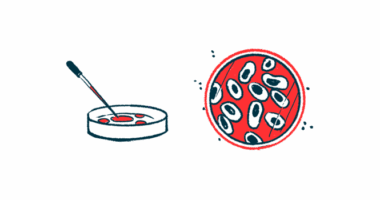‘Lot of Groundwork’ Behind MOXIe Trial’s Strong Results, Reata Executives Say in Interview

MOXIe, the Phase 2 study of oral omaveloxolone that may prove pivotal to it becoming the first approved targeted treatment for Friedreich’s ataxia (FA), succeeded in showing significant benefits to patients because of years of “groundwork” laid down by a patient group and researchers at Reata Pharmaceuticals, company executives said.
Topline trial results, announced this week, showed that nearly one year of daily treatment with omaveloxolone — widely called omav — led to a 2.40-point improvement in the modified Friedreich’s ataxia rating scale (mFARS), a first such finding that defies the disease’s natural history. Omav not only stopped the disease from worsening, but also helped patients recover some neurological function.
Reata announced plans to meet “soon” with U.S. Food and Drug Administration officials, and likely those in Europe and elsewhere, in advance of requesting that omav be approved to treat FA in the U.S. and abroad. It is also looking into the possibility of opening an early access program in the U.S.
How did MOXIe succeed, providing strong evidence of benefit, where other trials have failed?
“I think it’s the intersection of a lot of groundwork that had been laid by FARA,” the Freidreich’s Ataxia Research Alliance, Warren Huff, Reata’s founding president and CEO, said in an interview with Friedreich’s Ataxia News.
Ask questions and share your knowledge of Friedreich’s Ataxia in our forums.
“They have collected registry data on over 1,000 patients for many years, so they had a good sense of the natural history [of FA, and] … sponsored research that identified the target of our drug.” The group also worked closely with FDA regulators in establishing outlines for a trial design, Huff said.
In parallel, “we were developing a very powerful pharmacology for addressing these mitochondrial and inflammatory diseases. … It kind of all came together.”
Nrf2 and its role in mitochondria
One of the reasons omav shows a clear ability to help patients is because “the pathways that it turns on in patients with FA are known to be dysregulated,” said Colin Meyer, MD, Reata’s chief medical officer and executive vice president of product development.
“It’s been very difficult up until now to affect FA. All prior drugs that have been tried have not worked.”
While it is not fully clear why mutations in the frataxin gene (FXN) lead to FA, scientists believe that inside patient’s cells, mitochondria — cellular “power plants” — stop producing energy as they should and are damaged by oxidative stress.
Frataxin is a mitochondrial protein involved in making iron assemblies — called iron-sulfur (Fe-S) clusters — that are needed to activate enzymes involved in the production of energy (in the form of ATP) inside mitochondria.
In FA patients, there’s a shortage of frataxin inside cells and so iron cannot be loaded onto those enzymes, disrupting energy production.
Another consequence is the accumulation of free iron, which results in the build-up of harmful molecules called reactive oxygen species or ROS. These free radicals can lead to oxidative stress that damages and kills cells.
In the brain, spinal cord, and muscles, cells have high energy demands that can render them particularly vulnerable to problems in energy supply and oxidative damage, and possibly explain the signs and symptoms of FA.
Omav works by stabilizing and activating Nrf2, a transcription factor known for its protective effects against oxidative damage and in helping to resolve inflammation. (Transcription factors are proteins that regulate the expression of several genes.)
It helps to resolve inflammation by normalizing mitochondrial function, boosting energy production, triggering antioxidants, and suppressing pro-inflammatory signals.
But how does activating Nrf2 lead to changes in the neurological health of patients?
When the body responds to an insult, Huff explained, mitochondria quickly stop using oxygen to produce energy and instead release it as ROS to trigger inflammation that’s healing. But when an inflammatory response is no longer needed, that response needs to be shut down.
“It’s believed Nrf2 evolved to be the switch that switches things back to homeostasis, or normal,” Huff said. “It restores the mitochondria back to ATP production.”
Researchers working Friedreich’s ataxia saw that “mitochondrial dysfunction, high oxidative stress and chronic inflammation coupled with suppressed Nrf2″ were common in patients. The idea then “was quite simple,” Huff said. “If we can brute force Nrf2 back on pharmacologically, we can restore mitochondrial function and lower inflammation.”
Using animal and human cell models, Reata scientists confirmed that omav-induced Nrf2 production could restore mitochondrial function, protect against oxidative damage, and reduce inflammation.
mFARS and other essential first steps
Huff and Meyer also credit careful trial design, a FARA-supported study, and the choice of mFARS (the modified Friedreich’s Ataxia Rating Scale) as a primary measure of benefit for MOXIe’s success.
MOXIe was a two-part Phase 2 trial (NCT02255435) of omav’s safety, efficacy, and pharmacodynamics (its effects and mechanism of action) in teenagers and adults, ages 16 to 40.
In its 12-week first part in 69 patients, researchers determined the optimal omav dose, and gained key insights into how best to quantify disease progression and power their study.
Working with FARA and the FDA, they also collected information needed to shape a more robust, year-long and pivotal second part that included “multiple approaches to have data that would be strong,” Meyer said.
Its 103 newly enrolled patients were randomly assigned to either omav at 150 mg, or placebo capsules, once a day for 48 weeks. Then, as at earlier times throughout the study, mFARS — a four-section and physician-assessed neurological exam accepted by FDA as a relevant measure of omav’s efficacy — was used to determine benefit against placebo.
Patients in the trial’s primary population (82 people without high-arched feet, or pes cavus) showed significant improvement in muscular and neurological symptoms, corresponding to a 2.4-point reduction in their mFARS scores compared to placebo.
mFARS, a modified version of FARS, relies only on measures of patients’ physical abilities, including speaking and swallowing (bulbar function); use of arms, hands, and legs (upper and lower limb coordination); and an ability to stand and walk (upright stability). Its measures run a scale of 0 to 99, with higher scores representing more severe disease.
“If it weren’t for all that FARA did to provide funding for the natural history study to demonstrate that the mFARS scores are clinically relevant and what change is clinically meaningful, we may not have been able to do the trial,” Meyer said.
Seven of the MOXIe’s investigators were authors of an important study into FA’s natural history that FARA supported, the Reata executives noted.
In that study, an overall population of 812 patients was followed for five years, and their data used to determine rates of disease progression, identify sensitive measures and predictors of progression, and generate power calculations for clinical trials.
It also established that mFARS demonstrated a sensitivity as good as FARS to quantify changes in neurological function over time, and correlated well with how patients felt about their ability to function in daily life.
As FA patients lost function, their mFARS were seen in the study to rise by an average 1 to 2 points each year; people are typically diagnosed with scores of between 25 and 35.
“Once their score reaches approximately 55-60 they become wheelchair-bound and can no longer walk, and patients unfortunately die once their scores approach the upper end of the range,” Meyer said in a Reata webinar that accompanied the unveiling of MOXIe’s results.
Improvements in neurological function that were measured by mFARS in MOXIe also matched a greater sense of well-being reported by patients in surveys given: the Activities of Daily Living (ADL) and the Patient Global Impression of Change (PGIC).
These secondary endpoints were included “to determine if changes in neurological function, as determined by the mFARS and assessed by the investigator,” matched how patients thought “they felt or functioned,” Meyer said.
Better coordination was specifically seen in a 65% drop in the frequency of falls among treated patients and which, together with the responses given on ADL and PGIC, “suggest that omav may be having an impact on these patients’ daily life,” he added.
Both Meyer and Huff declined to delve into more detail on trial findings, saying they would be presented at science conference next year and detailed in a future publication.
P-values and natural history
Given that people with Friedreich’s ataxia progress in their disease at a fairly rapid pace, 1 to 2 mFAR points each year, MOXIe trial results appear especially strong.
But what does a 2.4 mFARS improvement mean, and why is it statistically significant?
On the one hand, a one-point change “is very meaningful,” Meyer said. On the other is the “p-value” of 0.014 that corresponded to that change.
P-value is a statistical measure that tells the chances of being wrong when saying that two conditions are different — in this case, omav versus placebo.
Thus, a smaller p-value provides stronger evidence that these differences are true (i.e., omav is better than placebo) and no major outliers mislead the effect. Normally, a p-value below 0.05 is accepted as significant.
It’s important to note that p-values support differences in data, but they are not measures of “clinical meaningfulness.”
Rather, clinically relevant is the fact “patients treated with omav for 48 weeks regained an amount of function that is typically lost in the course of one year,” as Meyer said.
“In our trial, the placebo patients worsened about a point and the drug-treated patients not only didn’t [worsen], but they recovered function,” he added.
Also impressive: According to the study on FA’s natural history and mFARS, more than 1,290 patients (ages 16-40) would need to be followed for more than one year to capture a 50% reduction in the 1 to 2 point worsening in disease progression they would experience.
In MOXIe, the 2.4-improvement seen was captured in mFARS measures taken at 48 weeks in 82 patients — those without pes cavus, because this foot deformity limits their ability to complete mFARS tests. Still, the overall patient population (those with and without pes cavus) saw a 1.93-point mFARS improvement against placebo.
That 2016 study also estimated that 2,000 patients would need to be studied over two years to show a difference in ADL.
“It was actually pretty profound that we were able to show a significant difference on the ADL with only about 82 patients,” Meyer said.
What’s ahead
Reata’s focus now is meeting with FDA and possibly other regulators, and exploring the possibility of an expanded access program.
One point of discussion will be whether children younger than those enrolled in MOXIe might be eligible for omav, should it be approved. “Patients are typically diagnosed at the ages of 10 to 15 up to 20, so there is a meaningful number … younger than 16,” Meyer said. “That’s a reason why we need to go deal with FDA as soon as possible.”
But whether doses would need to be adjusted for younger ages and smaller bodies is a question. “If we need additional data, we would then try to collect it as soon as possible,” he said.
“We’re super excited about the results. We had a lot of hope and felt like our trial was likely to be successful,” Meyer added. “We’ll be working closely with FARA and the investigators as we proceed.”
Editor’s Note: A second article into the MOXIe trial, looking at steps Reata took to ensure the reliability of reported outcomes with omav’s use, can be read by clicking here.






